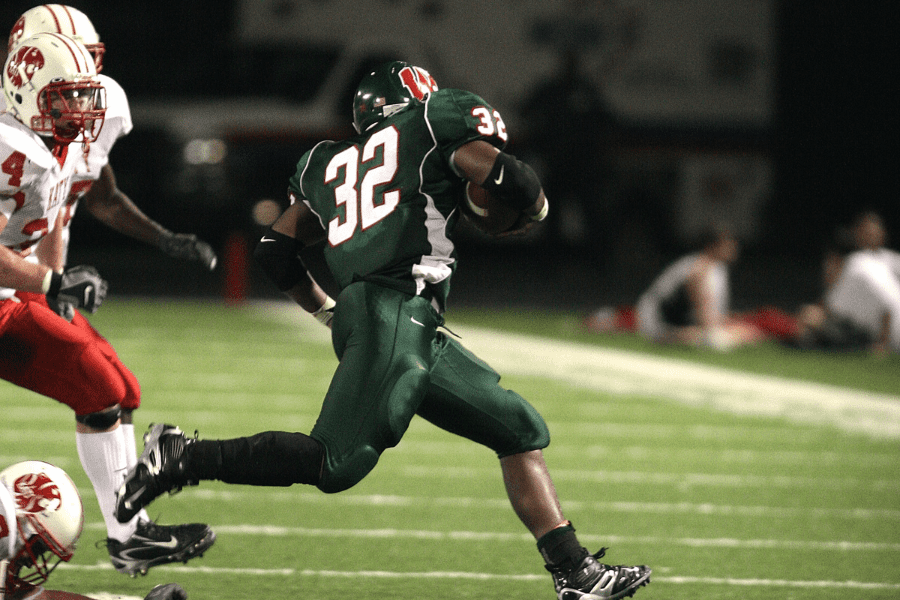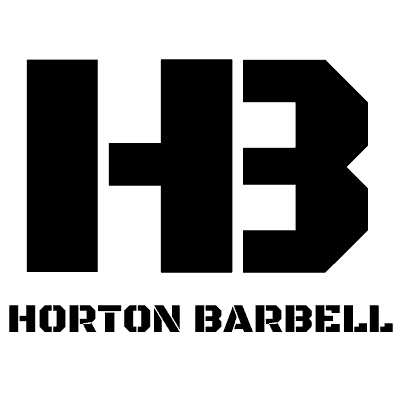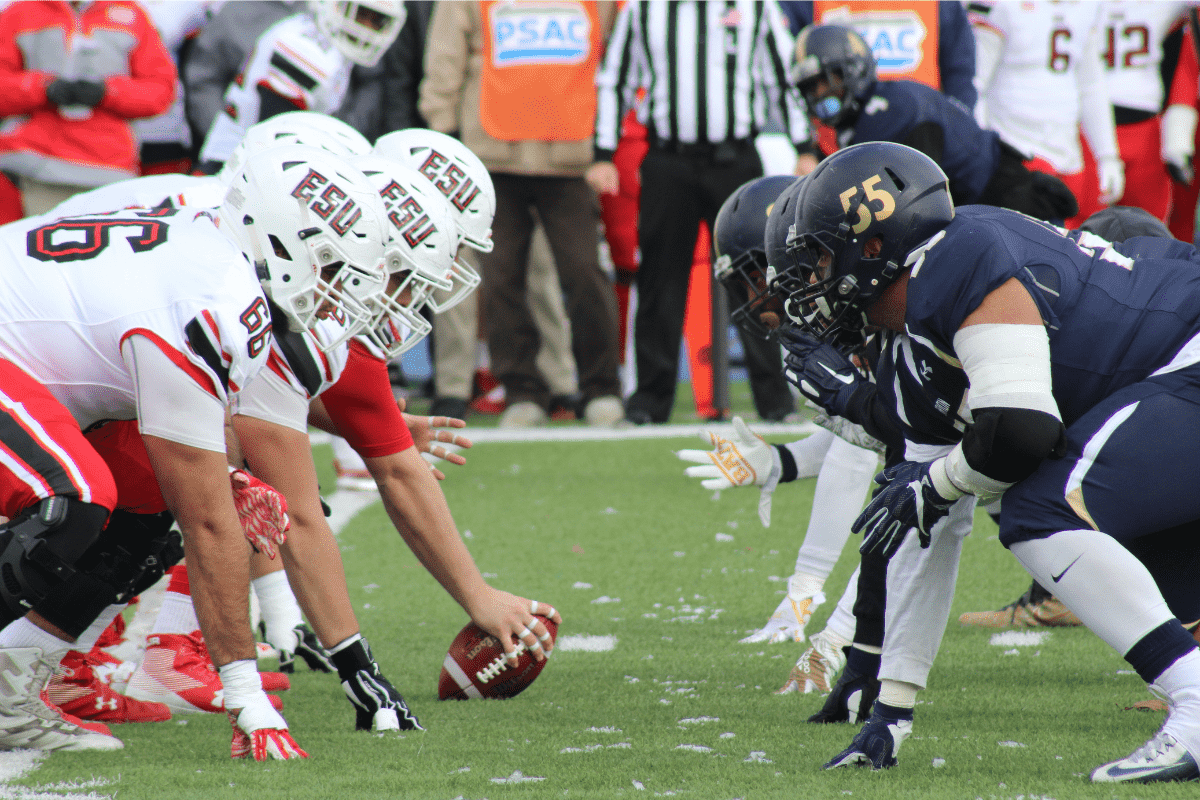Should Football Players Lift In-Season? (Yes, Here’s Why)
Whether football players should lift in-season is one of those questions that I get asked quite a bit, yet am always surprised when I do. For me, the answer is ridiculously obvious – yes, of course, football players should lift in-season.
In this article, I’m going to discuss why in-season lifting is so critical for football players. I’ll also go through how off-season lifting should differ from in-season lifting.
Why In-Season Lifting for Football is Important
To Stay Healthy
If we all can agree that lifting weights helps reduce the risk of injury for football players, then why would we want to stop lifting once the season starts?
Depending on what level you play at (high school, college, etc), football season starts around the start of August and doesn’t end until December (and for some teams, even January). That’s roughly five months.
Maximal strength levels can be maintained for up to three weeks according to research but will begin to decay after that. This means that by the time football camp is over and the season actually starts, players will already be losing strength.
This also means players would be increasing their risk of injury just as games begin to be played.
To Optimize Performance

Continuing with this idea of losing strength throughout the season by not lifting weights, let’s think about the most critical time of the year: Championship Season. Whether it’s conference championships or playoffs, the biggest games of the year happen at the end of the season.
If you’re not lifting to maintain (or even increase) your strength throughout the season, you’ll actually be at your absolute weakest of the entire year when it matters the most!
Next, you have to think about how your in-season training carries over to the following off-season. If you’re able to maintain your strength levels through the season, you get to start making progress almost immediately after the season.
However, if you allow yourself to lose strength during the season, you may end up spending a good chunk of your off-season merely getting back to where you were before. This is going to put you way behind your competition.
Finally, this isn’t just detrimental to the current season or even the following season. It can have a cumulative effect over the entire course of an athlete’s playing career.
As I mentioned earlier, the football season lasts up to five months, almost half the calendar year. Over the course of a four-year period, you’d be losing out on over a year and a half of training. Imagine how much progress you could make in a year and a half.
Need a Training Program?
Visit the Horton Barbell Shop and Use Code “HB10” for 10% Off ANY Program!
Off-Season Lifting vs In-Season Lifting

Now that you understand the importance of in-season training, let’s discuss what in-season training should look like.
It’s actually going to look pretty similar to off-season strength training with a few key differences.
Days Per Week
Days per week will change between the off-season and in-season and will also depend upon each player’s role during the season.
In the off-season, we’ll lift four days a week for most parts of the year. During the season though, we have a two-day, three-day and four-day program. We assign each player on the team to one of these three programs.
Players getting significant playing time will lift two days per week. Players getting very limited playing time (maybe playing on one of the special teams) will lift three days per week. Finally, redshirts and/or players not getting playing time will lift 4 days per week.
This setup allows us to optimize performance on game day for players playing significant reps and to still optimize development for everyone else.
Volume and Intensity
Before we go any further, there are two terms that we need to go over: Volume and Intensity.
Volume refers to the total amount of sets and reps that are done in a given workout, week and overall cycle. For example, if you Bench Pressed 5 sets of 5 on Monday, the volume would be 25 reps for that workout. If you also Bench Pressed on Friday, 3 sets of 10, the volume for that workout would be 30 and now it would be 55 for the week.
Intensity refers to the load being used, usually in the form of percentages. For example, 5 sets of 5 at 60% would be really easy, but 5 sets of 5 at 75% would be pretty tough.
I’m simplifying here a little bit, but hopefully, you get the general idea.
The biggest difference between in-season lifting and off-season lifting is volume. Intensity will be cut back some, but not drastically – most work sets will fall between 70% and 80%.
However, the volume will be cut significantly. A typical Back Squat day in the off-season may call for 25 to 30 total reps while an in-season Squat day may not even be half of that.
Volume is the biggest contributor to soreness and fatigue. My goal is to keep players as strong as I can while still making gameday the priority.
Exercise Selection

The exercises that I use to train football players don’t change much from off-season to in-season with two exceptions.
I’m a big believer in Olympic lifts and we Clean quite a bit in the off-season. During the season, we will still do Clean Pulls and even High Pulls, but I do not have players catch the bar. This means no full Cleans and no Power Cleans.
Football can be brutal on wrists and many players, especially linemen, and I don’t want to contribute to that during the season. Clean Pulls allow us to still work triple extension, even without catching the bar.
The other difference is we do much less full Bench Pressing. We do a lot of Board Press, Floor Press and even Dumbbell Bench – but not very much regular Bench Press. This is to take some of the stress off of the shoulders which also can get beat up during the season.

Online Strength Programs
- 1-on-1 Online Coaching
- Sports Performance Programs for Football, Basketball, Soccer & More
- Programs for Former Athletes (Legends) Who Still Want to Train Like Athletes
- Programs for Adults Who Want to Get Healthy (and look great at the beach!)
- Use Code “HB10” to Get 10% Off Today
Final Thoughts
Should football players lift during the season? Yes!
The season is too long to not continue to train. Lifting will increase your chance of staying healthy through the season and will have you prepared to play at your best when championships are won at the end of the season.
Lower your volume, train smart and in-season lifting can be an absolute key to your success on the field.

